A new beginning
This quest for the Turgovian Pear began on the 1st of December 2020, when Jim Chapman of the National Perry Pear Centre asked me if the name resembled any pears currently known in Switzerland and Germany. I think I can now finally put to rest the question of what the Turgovian pear actually was or, rather, what it is.
Part one of this quest was published over a year ago and outlines the correspondence and literature mentioning this fabled pear, that was lauded as making “the most superlative perry” the world has ever seen. If you haven’t read it yet, it might be worth doing so for the full context. But essentially, it all began in 1658 with missives from John Pell, Cromwell’s ambassador in the Swiss cantons, writing back to England about an incredible pear and the methods of perry making used there. In 1666, a bottle of the perry itself was presented to Royal Society members, including scion wood of the “Turgovian pear” for propagation. Once Evelyn mentioned it in his Pomona of 1664, its legend grew in the parlours of British pomologists over the next century, but somehow it got stuck as a footnote in perry history, a curious mystery that appealed to perry pear geeks, its origins lost. The first round of research also made an initial attempt to suggest varieties it might be, but on reflection, in a very naïve way. I’ve often thought it was really remiss of Pell not to simply write the name of the pear itself instead of just more or less saying “that pear from Turgovia”. But it was a start.
As with many things in life, it’s happenstance that sometimes starts a person off on a new thread, and in this case, a new line of enquiry was kicked off after a chance question.
Josef Löschnig, 1913
There is a book for which I had been searching since starting this research, Die Mostbirnen by Josef Löschnig, as I knew it had a description of at least one of the pears I felt might be a candidate for the Turgovian pear. A book published in Austria in 1913, it is, I believe, the first book ever published that is solely focussed on perry pears. Austrian perry pears of course, of which there are plenty. The usual sources for scans didn’t have any publicly available, but last year I managed to find a company in India that would print it on demand based on a scan they had. Duly ordered, I received a fairly nice book, though the plates were often a bit blotchy, with a moiré effect from the scanning process. But I was able to look up the candidate and quickly discount it from the research list (it was the Sülibirne, for those interested).
But the poor quality of the pear images always bothered me, and I would occasionally look online to see if a scan had surfaced, as Löschnig had died in 1949, theoretically placing his book into public domain. Through luck and some wonderfully kind contacts, I was able to acquire a scan of Löschnig’s book, simply in order to see if the image quality would be better than the reprinted version I had bought. Sadly, it looked like the same scan that the printers in India had used.
However, digital versions of old books have a massive advantage when character recognition has also been employed as they are then searchable. Almost the first thing I do when I acquire a new digital book on pomology, whether in German or English, is to search for Thurgau and its variants, just in case there are some clues that might narrow down the search for the true Turgovian Pear. Often there is a mention of the Swiss Canton, but nothing of any major significance. Until I searched Die Mostbirnen I’d probably flicked past this entry in the book quite a few times but, as it’s more a reference book and not a necessarily something you’d sit and read, I had missed an important description, a translated extract of which I present here:
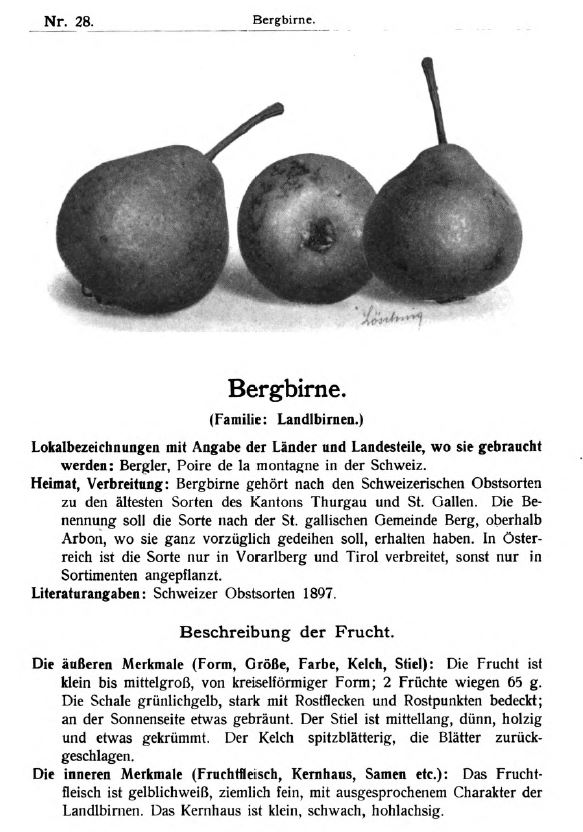
Bergbirne.
Local names: Bergler, Poire de la montagne
Origin and spread: Bergbirne is one of the oldest varieties in the canton of Thurgau and St. Gallen, according to Schweizerischen Obstsorten. The name apparently originates from the district of Berg, above the town of Arbon in St. Gallen, where it is said to thrive quite excellently. In Austria it has only spread through Vorarlberg and Tirol, and is otherwise only found in planted collections.
Value and uses of the fruit: Bergbirne is a Swiss variety that deserves attention in neighbouring countries. Due to its high tannin content, it should be used in a mix with other varieties or letting them ripen completely before use.
Well, that was interesting. One of the oldest varieties to come out of Thurgau and highly tannic. More searching was needed, as no other books in my possession spoke about this variety. But Löschnig had mentioned another source: Schweizerischen Obstsorten.
Gustav Pfau-Schellenberg, 1863
I believe Löschnig meant Schweizerischen Obstsorten by Gustav Pfau-Schellenberg, published in 1863 (2nd Ed. 1896) in Switzerland. As the name suggests, a description of key fruit varieties found in Switzerland, specifically apples and pears. This was easily available online as a scan, and there were almost two pages of detailed description of the Bergbirne, plus a watercolour of the pear itself. I won’t reproduce the text in its entirety here, but here are some key sections that really grabbed my attention:
“The Bergbirne tree belongs to the oldest, most native variety of the Thurgau and St. Gallen fruit woods, where it is not just the most common, but also the most beautiful, largest examples of pear tree to be found in the St. Gallen district of Berg, above Arbon. Out of this region it was planted in many other Cantons, but also in Württemberg and Baden [at the time a Kingdom and a Grand Duchy, respectively, at the southern end of Germany].
The tree grows very slowly and first carries fruit usually after 30 or 40 years; on the other hand, they reach an age up to 200 years. Once started, they carry fruit almost every year and richly.
The Bergbirne, also called “Bergler”, belongs to the smaller class of pears, is fat-bellied, turbinate, flattened at the calyx end and runs to a blunt shape at the stalk.
The Bergbirne remains, as in olden times, a perry pear of the first class. Its juice was praised more than 300 years ago by the learned Vadian, and one can easily recognise from the early boiling down to half of the juice quantity that this drink should indulge a value such that the resulting product would be treasured as much as a grape wine.
The juice has an excellent flavour, with lots of spirit and has a shelf life of at least 2.5 to 3 years. To preserve a nice yellow juice, one must let the pears be fully ripe and sweat them in heaps, which in mild weather happens in a couple of days. In bad years the juice of the Bergbirne would be used to mix into grape juice to improve and sweeten the sourer wine”.

Now, there’s a lot to take in there, but some key phrases really rang some alarm bells. One of the oldest native perry pear varieties. Ok, that’s good. Famed for over 300 years at the time of writing, taking it back to the 1500’s. Oh, that’s pretty old! Boiling it down, exactly as John Pell described in his letter to Hartlib back in 1658. A fascinating crossover, but maybe that was simply a common technique there at the time. Of a quality comparable to wine, and with long keeping properties. Yeah, that sounds like a decent pear. Pretty circumstantial, I know, but that’s quite a few boxes being ticked that matched with Pell’s very first descriptions of the “Turgovian Pear”.
Still more research was needed, but at least this time there was an actual name to search for. I‘ve already said it was rather naïve to simply begin this quest looking for pears with Turgovia/Thurgau in the name. Pell was writing about a pear that came from a place, but not necessarily named after that place, but now, armed with Bergbirne and Bergler as my weapons, it was back into the fray.
The idea was to find as many early mentions as possible of the Bergbirne/Bergler to get a better feel for what the pear was like, how common it was and how it was used, to compare to the description from Pell.
Eduard Lucas, 1855
The first stop on the trail was with a very famous and influential German pomologist, Eduard Lucas. In the very first volume of the Pomological Monthly Magazine from 1855, Lucas described a visit to a fruit exhibition in Thurgau, in which he wrote of his travels through that canton:
“My way led me through a large part of the canton of Thurgau. It would be difficult to find another region in the north or south that surpasses the Thurgau in terms of magnificent and well-maintained fruit plantations, which one could justifiably call a large orchard. These rows of trees, especially pear trees, among which the long pear (Wadelbirn) and the Schweizer Wasserbirn (Thurgaubirn), as well as the long-stalked pear (Griese- or Friesebirn), which we encounter everywhere in numerous specimens, certainly amaze every connoisseur and friend of fruit culture who visits this region for the first time. However, one cannot hope to find a large selection of fine dessert fruit here; the predominantly planted varieties are mostly used only for making Most [perry] and for drying (in pieces), but it is precisely because they can be used for economic purposes, as they are processed en masse, that such extensive fruit plantations are counted among the most profitable crops here, where the soil has such a high value. However, the trees only belong to those varieties which, after hundreds of years of experience, are recognised as the most sustainable and usable, as those which are entirely suitable for the local climatic and soil conditions, and no Thurgau native would agree with the assertion that a Beurré Blanc pear tree yields [offers?] more than the completely inedible Berglerbirn or the local Weinbirn. The distance of 40-50 feet at which the trees are planted on the meadows and fields there seemed to me to be particularly worthy of imitation, and the very simple method of protecting them from damage by the farming tools, as well as the fact that for the most part the crowns were well thinned out and freed from the barren inner wood”.

A very quick mention of the Bergler there, but commenting that it was inedible, supporting Pell’s statement that it was an “ill-tasting pear” that the hogs wouldn’t eat. But what an amazing image he paints of the Thurgau landscape and the richness of perry pear trees that were clearly an important part of their economy (and bonus points for the agroforestry). The realisation that varieties had been selected over 100s of years of use, so that they fit perfectly to the local conditions while providing a wonderful product. It seems so strange that perry does not seem to have survived in Switzerland so well today, at least compared with neighbouring Austria.
In the same publication, Lucas went on to describe the exhibition itself:
“To enumerate the cider pears here would tire many of the honoured readers of this journal, as these varieties have not yet been described anywhere, despite the fact that they are found here in general distribution [in Thurgau] and are counted among the most useful and tolerable fruit trees. I will mention only a few of the most common and valuable varieties: the Thailersbirn, Schweizer Wasserbirne, Höhnenbirne, Guntershauserbirne, Strickbirne, Fischbächler, Späte Weinbirn, Bergler , Sülibirn, Eschemer Holzbirn, Kalchbühler“.
All varieties that are going onto my own shopping list now. And:
“I do not need to assure you of the great value of this exhibition and the beneficial effects it had on the improvement and perfection of fruit growing, given the lively interest of the Swiss in agriculture and garden culture and the energy with which the esteemed President of the Agricultural Society, Prof. Dr. Heer, and the above-mentioned gentlemen devote themselves to the affairs of the Society. A large number of orders for fine scions and trees, which are imported from there to Hohenheim, may also be proof of the newly awakened zeal for fruit culture”.
Here, Lucas almost channels Evelyn in extolling the virtues of importing quality and suitable varieties for use in his home country, leading me to assume that Bergbirne/Bergler also made its way to Germany around this time. Some of the other varieties he mentioned certainly already had.
But again, nothing massively conclusive there, other than the fact that Bergler was considered very valuable by the locals, that perry pears were important economically, and that the quality was considered high.
Caspar Tobias Zollikofers, 1830s

I came across mentions of Bergler/Bergbirne that referenced work done by Caspar Tobias Zollikofer, a Swiss pharmacologist and pomologist, in the 1830s. One of the few sources I found was for a watercolour and description of the pear held in the Thurgauer State Archive, which kindly took photos of the originals for me and gave permission to reproduce them here. My wife is often surprised that I can read old German spelling and vocabulary in Fraktur, but here I am almost lost. The title is clear, Bergbirne Thurgau, and the last line reads “Eine der beliebtesten Mostbirnen“, or “one of the most popular perry pears”. I need to work through it with some care, but essentially it is a description of the characteristics of the pear itself. But what a beautiful watercolour!
I have ordered a book that contain facsimiles of Zollikofer’s pomological descriptions and watercolours, so I hope that has the text is in a modern font so I can read it with more ease.
Johann Konrad Fäsi, 1766
The final stop on this journey was not to be with a pomologist, but rather with Swiss pastor, historian and geographer, Johann Konrad Fäsi who, between 1765 and 1768, described life throughout the confederation of Swiss Cantons. Published in four volumes, the title of his main work in German is a bit of a mouthful: “Genaue und vollständige Staats- und Erdbeschreibung der ganzen helvetischen Eidgenoßschaft, derselben gemeinen Herrschaften und zugewandten Orten”, or An Accurate and Complete State and Geographic Description of the entire Helvetic Confederation, its Common Dominions and Associated Places.
The chapter on Thurgau, published in the third volume in 1766, contains a section dedicated specifically to Turgovian perry, my translation of which I will repeat in its entirety, as the details made my jaw drop:
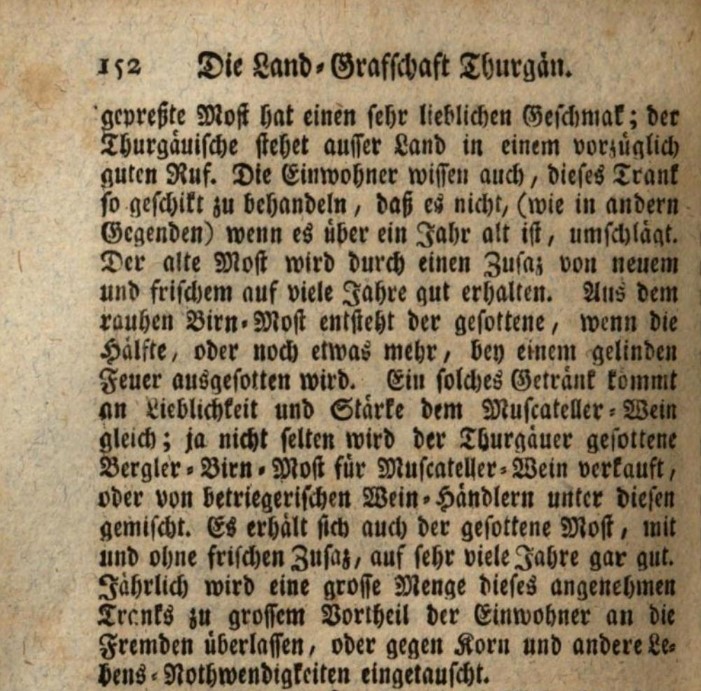
“There is another style of drink prepared in the county [of Thurgau], namely Birnen-Most, which is made from pressing pears, primarily Bergler pears. Masses of fruit is planted throughout the entire state, especially throughout Upper Thurgau. The fruit trees are uncountable; they are not just planted in meadows [Wiesen], but also in tillage [Feldern]. Every ditch edge is planted with a variety of fruit trees. In Upper Thurgau there are many fields planted only with Bergler pear trees. Because the trees are maintained with special care and, insofar as possible, planted high up [maintained as high stem standard trees], the disadvantage they cause to the grain is very slight. The must pressed from the Bergler pears has a very sweet taste; the Turgovian has an excellent reputation outside the country.
The inhabitants also know how to treat this drink so cleverly that it does not, as in other regions, turn bad when it is more than a year old. The old perry is kept good for many years by adding new and fresh perry.
The raw juice is turned into a boiled perry [gesottener Most] when half of it, or a little more, is boiled down over a gentle fire. Such a drink is equal in sweetness and strength to Muscat wine; indeed, it is not uncommon for Thurgau’s boiled Bergler pear perry to be sold as Muscat wine, or for it to be mixed with it by deceitful wine merchants.
Boiled must, with or without the fresh additions, also keeps very well for many years. Every year, a large quantity of this pleasant drink is given to foreigners to the great advantage of the inhabitants or exchanged for grain and other necessities of life”.
What an amazing description! From the magnificent imagery of a landscape covered in perry pear trees, to the description of working agroforestry combining grain crops and managed trees together in one field. We have lost a lot to mechanisation over the last century.
But go back to Part I of this quest and look at the second letter from Pell to Hartlib in London in 1658. Make a mental checklist then come back and re-read Fäsi’s entry from about 100 years later. The overlap of specific details is quite astonishing, but while I had a brief pang of fear, I don’t think Johann Conrad Fäsi had access to Hartlib’s private papers at the time!
Entire fields were planted with the Bergler pear, meaning it was likely the most common perry pear in Thurgau at the time. It was expressly used for making highly regarded perry, both a regular pressed version, and a boiled down version, precisely as Pell described. It was kept for years by topping up barrels with new, fresh juice or perry. It was comparable to Muscat wine. All aspects which Pell had remarked on, especially as he had drank a 10 year old perry that had been prepared in the same way, topping up older perry with new juice. Multiple checkboxes being ticked!
Again, I had to wonder what the hell happened to the thriving perry culture of Switzerland? But that’s probably a topic that deserves its own research thread, I had to stay focussed.
Joachim Vadian, 1529
But maybe one more check. Schellenberg mentioned a name in his description of the Bergler Birne, the “learned Vadian”, whom he said had mentioned the Bergbirne more than 300 years previously. Joachim Vadian (1484 – 1551) was born Joachim von Watt, a humanist, scholar and one time mayor of St. Gallen, Switzerland. In 1529 he published a history of the abbots of the abbey of St. Gallen, and in there, under the entry for Thurgau, he makes the following statement:
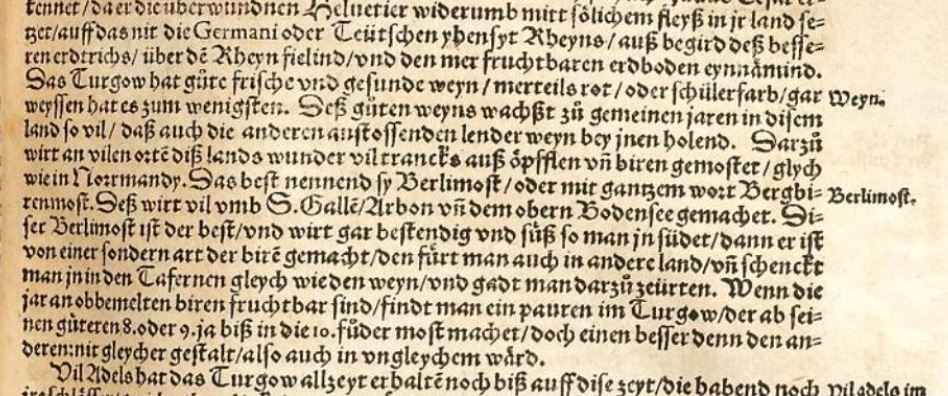
“The Thurgau has good, fresh, and healthy wines, mostly red or iridescent, rarely white; so much of it grows in ordinary years that the neighbouring countries also get wine from there. In addition, in many places in the country, a wonderful drink is made from apples and pears, just as in Normandy. They call the best Berlimost or, in full, Bergbirnenmost, which becomes very stable and sweet when it is boiled, made from a special kind of pear. It is also delivered to other countries, served in taverns like wine; it is served at the Ürte. When the years are fruitful with pears, one finds a farmer in Thurgau who makes 8, 9 to 10 fuder of perry from his estates, but the one better than the other and not of equal value.”
And there you have it. 1529, possibly the earliest recorded mention of the Bergbirne and the quality perry made from it, right down to mentioning the additional boiling process, a good 120 years before Pell was stationed in Zürich. And the volumes mentioned? Ten “fuder” in that location at that time would have been the equivalent of 15,310 litres. From one farmer.
The end of the Quest?
In a way, this is still all circumstantial, but I believe that such is the weight of the evidence that I am happy to declare that Bergbirne/Bergler is the true name of the Turgovian Pear so praised in England in the late 17th Century. It was the pear of choice for making the local variant of perry. A specific style of boiled Most was named after it, and the descriptions from locals match entirely what Pell reported. It was a variety that was widely planted and respected for 100s of years in Thurgau, it surely could be no other.
So what next? Well, I’ve already found it in the Swiss national collection, and my friend there will gladly send me scions to graft in 2023. This would be the prime candidate to compare to the DNA profiles of perry pears in the UK, just on the chance that the scions sent over with Theodore Haak to the Royal Society in 1666 really did take and spread under a different name there. And as Jim said to me after I informed him of my discoveries, there are some moves to improve the resolution of DNA analysis and cooperation across various database holders in Europe and beyond, so there may be even more to tell on how interrelated European perry pears are, and where the famed Bergler fits into that ancestry.
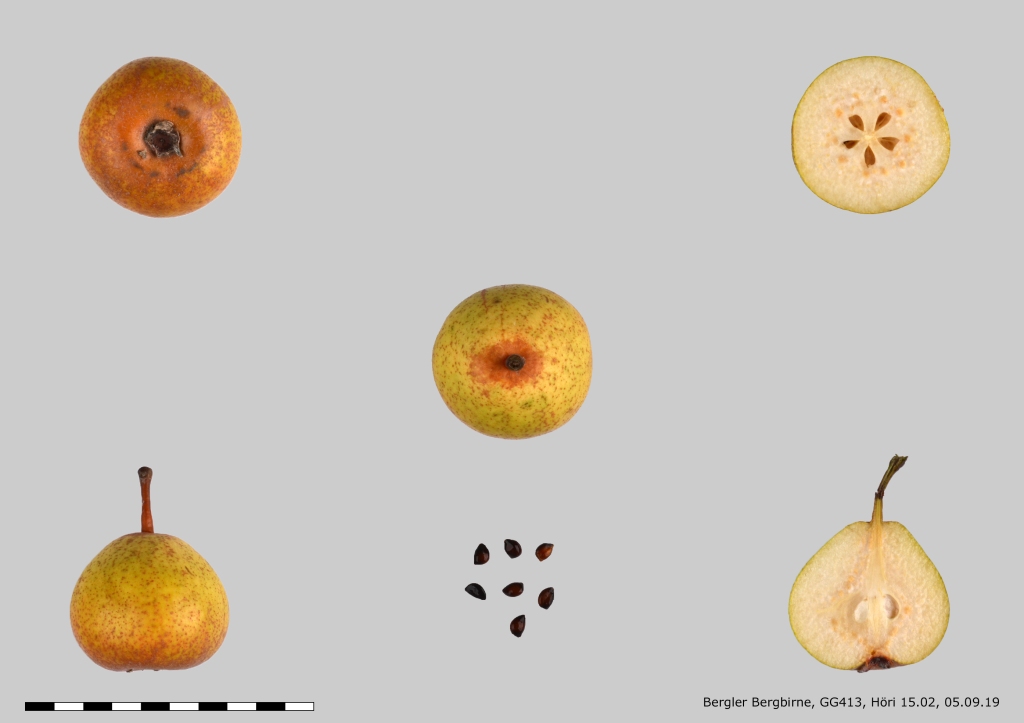
For my own part, given the number of years it takes for the trees to bear fruit, I fear I shall never taste what Evelyn described as “the most superlative perry the world certainly produces”, unless we drive to Thurgau and try to find someone willing to let us harvest from their trees (and believe me, I would do it!). But it won’t stop me from trying to establish a small population here in Schefflenz for future generations.
References
- FOAG, 2019. Profile photo of the Bergler/Bergbirne from the Swiss National PGRFA collection. Photo by Fructus.
- Fäsi, J. K. (1766). Genaue und vollständige Staats- und Erdbeschreibung der ganzen Helvetischen Eidgenoßschaft (etc.). Switzerland: Orell.
- Löschnig, J. (1913). Die Mostbirnen: Beschreibung der in Österreich am häufigsten angepflanzten Mostbirnensorten. Austria: F. Sperl.
- Schweizerische Obstsorten. (1863). Switzerland: Schweizerischer Landwirtschaftlicher Verein.
- StATG, 2022. Photographs of Zollikofer’s description and watercolour of the Bergbirne. StATG C 0’1, 18/9, 13 © Staatsarchiv des Kantons Thurgau. Also cover image.
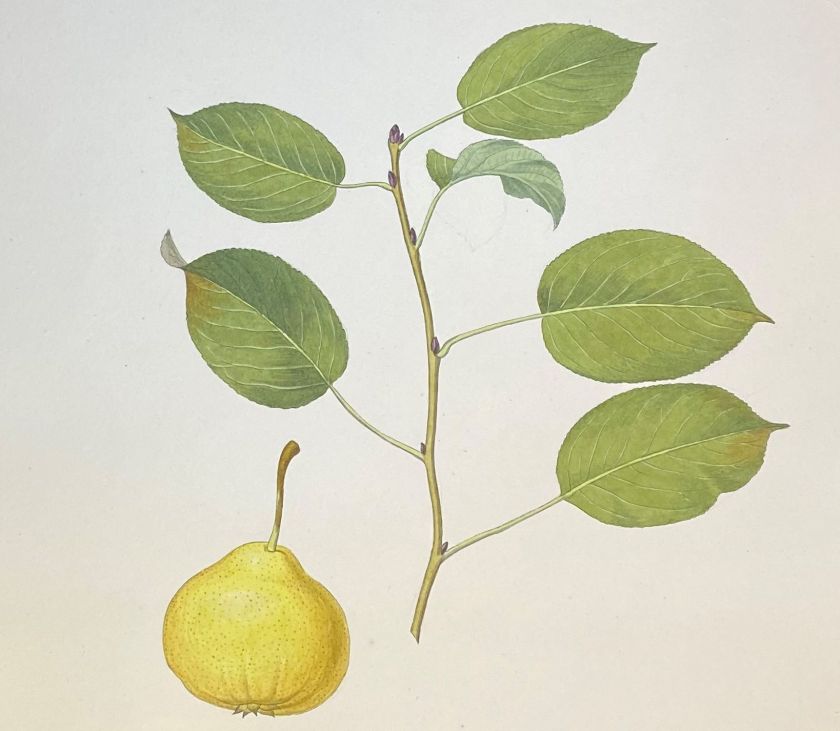
Interesting research on the Turgovian Pear. Thanks 🙂
LikeLiked by 1 person
Wow! I loved this historical adventure in perry pears! And would love to get my hands on some of that scion too. Sweden doesn’t have that many perry pears.
LikeLiked by 1 person
I’m glad you enjoyed the story 🙂
There are a great many perry pear varieties also worth considering. Whether the Bergler appeals to modern tastes remains to be seen 🙂
LikeLike
Pingback: The Swiss Tree Murder – Part 1 | Cider Review
Pingback: The Quest for the Turgovian Pear: Part I | Cider Review
Pingback: Planting an Orchard in an Age of Change | Cider Review